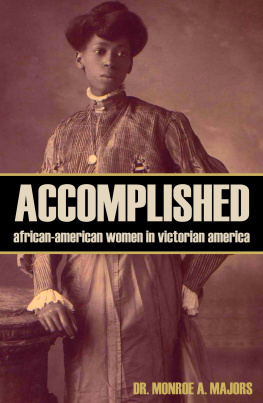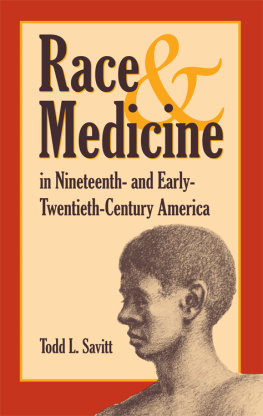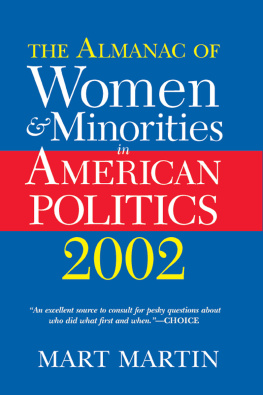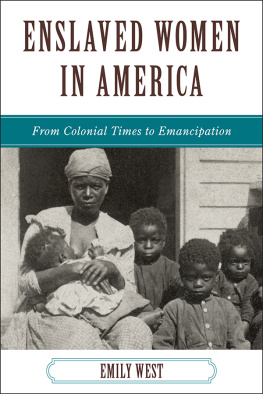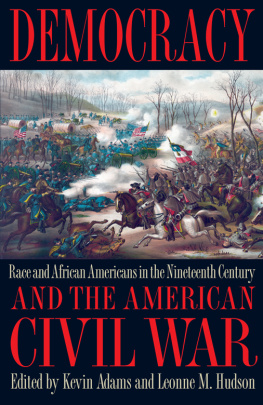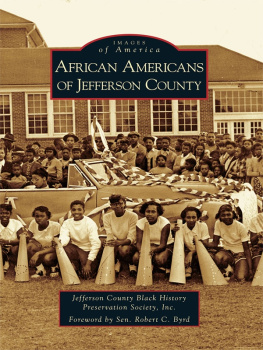
ACCOMPLISHED
AFRICAN-AMERICAN WOMEN IN VICTORIAN AMERICA
ORIGINALLY PUBLISHED AS NOTED NEGRO WOMEN
THEIR TRIUMPHS AND ACTIVITIES
BY
M. A. MAJORS, M. D.
A race, no less than a nation, is prosperous in proportion to the intelligence of its women.
1893
COPYRIGHT 2015 BIG BYTE BOOKS
Get More Great Reading from BIG BYTE BOOKS
NOTES
In 1886, Dr. Monroe A. Majors became the first African-American physician in the city of Dallas, Texas. It is remarkable that, given the era of his birth and its location, we know exactly when he was born: October 12, 1864 in Waco, Texasa state that at that time was in rebellion against the federal government as part of the slave-holding Confederacy. Federal census records vary in the recording of his race, sometimes listing it as black and sometimes as mulatto.
Majors practiced medicine in California for two years (1888-1889), being the first African-American to pass the California Board of Medical Examiners. He then returned to Waco, opened the first African-American pharmacy and helped found the first African-American hospital in the still-segregated south. He later helped found the Negro Medical Association.
He met Frederick Douglas and two of Harriet Beecher Stowes granddaughters. He moved to Chicago where he was appointed by the mayor to the Board of Health Commissioners. While practicing in Chicago, he treated prominent white patients, which attracted wide attention. He added Paralytic Diabetes to the medical nomenclature.
For more than fifty years, Majors was a prodigious writer for medical journals, newspapers, and magazines, even being quoted in the British Lancet . In addition to the present work, he wrote Ode to Frederick Douglas and Nursery Rhymes for Colored Children .
In this book, Majors profiles over one hundred women of accomplishment. Due to the length of the Table of Contents, weve moved it to the end of the manuscript so that it doesnt take up all the space in e-book previews.
He married to Georgia A. Green (1863-?) in 1889, an accomplished woman and graduate of Oberlin College and Fisk University. Monroe Majors died in 1960.
DEDICATION
The surest way to demonstrate our true devotion to our sisters is to write a volume depicting their lives, achievements and activities.
The strongest proof that we appreciate the high ground our sisters have reached, consequent of their tireless efforts for the good of humanity, is to DEDICATE this volume to their unspotted lives.
THE AUTHOR.
INTRODUCTION.
Dr. M. A. Majors, who in this work has, in my opinion, given the world a book covering rich and hitherto neglected ground, was born in Waco, Texas, October 12, 1864, of honored parentsAndrew and Jane Majorswho now reside in Austin, whither they moved, in 1869, to secure the at that time best educational advantages for their children in the State; Waco being not then as now the Athens of Negro education, where is situated Paul Quinn College, a very superior school of high and industrial education.
After attendance continuously and successively upon the public schools, West Texas College, managed by the Freedmen's Aid Society; and Tillotson Institute, under the auspices of the A. M. Association, he was appointed assistant mailing clerk in the post-office, which position he resigned, in 1882, to enter Central Tennessee College, Nashville, Tenn.
He relinquished his literary course in October, 1883, to enter the Mcharry Medical College, from which he graduated in February, 1886, with honor, being salutatorian in a class of ten, thus completing his professional course at twenty-one years of age.
During his school life at Nashville he conducted the department of penmanship for the whole college, and was conspicuous as a reporter for the local daily and weekly papers on all public occasions.
Since graduation as a physician he has practiced in different parts of the State of his birth, as well as for some time in Los Angeles, California. He is the first to advocate the organization of the Lone Star Medical Association, the first Negro medical association ever organized in America. While in California, Dr. Majors married Miss Georgia A. Green, of Texas, an accomplished lady, in 1889.
Dr. Majors was a welcome associate in the medical societies of California, where his color was no bar to his participancy in the proceedings. He was invited to lecture on medical topics before the Los Angeles Medical College.
He was also very active in the political life of the State, and through The Western News , a paper which he edited, secured recognition of his race on the police force, in city public works, and in the office of assessor and collector. Prior to this no Negro had ever been so employed in any of the departments of the city.
Returning to Texas, in 1890, he at once began the compilation of Noted Negro Women .
This merited recognition of the virtues and force of the noted women of the race, whose work and influence have all too long been unnoticed, will receive at the hands of a discriminating public the attention its importance demands.
Epic in subject, inspiring in effect, it is no less true in fact, and only a culling from the wealth of similar material supplied in the lives of hundreds of others, who, though possibly less eminent in the public eye, are no less true, devoted, capable, and noble exemplars of our possibilities and queens in our homes.
H. T. KEALING,
Waco, TEXAS.
President Paul Quinn College.
PREFACE.
I regard a true woman as the best, the grandest of all God's human creatures; a being of light, immaculate in her chastity, a paragon in her purity and capable of ennobling the man of her liking. A woman's gentle spirit is an all-pervading virtue, whose influence softens the spell and fills our life niche with its calm soul fragrance. Her smile intensifies our joys and leads us to forget the bickerings, the sins, the hard, angular elbowing in the avaricious competition of a calloused world and opens our eyes to the brighter, the better side of earths paradise.
Foster .
Here spaces of labor, wide as the world, lofty as heaven. A virtuous enthusiasm is always self-forgetful, virtuous and hence noble. It is the only inspiration now vouchsafed to man. Like Pickering, blend humility with learning. Like Story, ascend above the present in place and time. Like Alston, regard fame only as the eternal shadow of excellence. Like Channing, bend in adoration before the 'right. Cultivate alike the wisdom of experience and the wisdom of hope. Mindful of the future do not neglect the past; awed by the majesty of antiquity, turn not with indifference from the future. True wisdom looks to the ages before us, as well as behind us. Like the Janus of the Capitol, one front thoughtfully regards the past, rich with experience, with memories, with the priceless traditions of virtue; the other is earnestly directed to the All Hail Hereafter, richer still with its transcendent hopes and unfulfilled prophecies. We stand on the threshold of a new age, which is preparing to recognize new influences. The ancient divinities of violence and wrong are retreating to their kindred darkness. The Son of our moral universe is entering a new ecliptic, no longer deformed by those images of animal rage, Cancer, Taurus, Leo, Sagittarius, but beaming with mild radiance of those heavenly signs, Faith, Hope and Charity:
There's a fount about to stream,
There's a light about to beam,
There's a warmth about to glow,
There's a flower about to blow,
There's a midnight blackness changing
Into gray;
Next page
